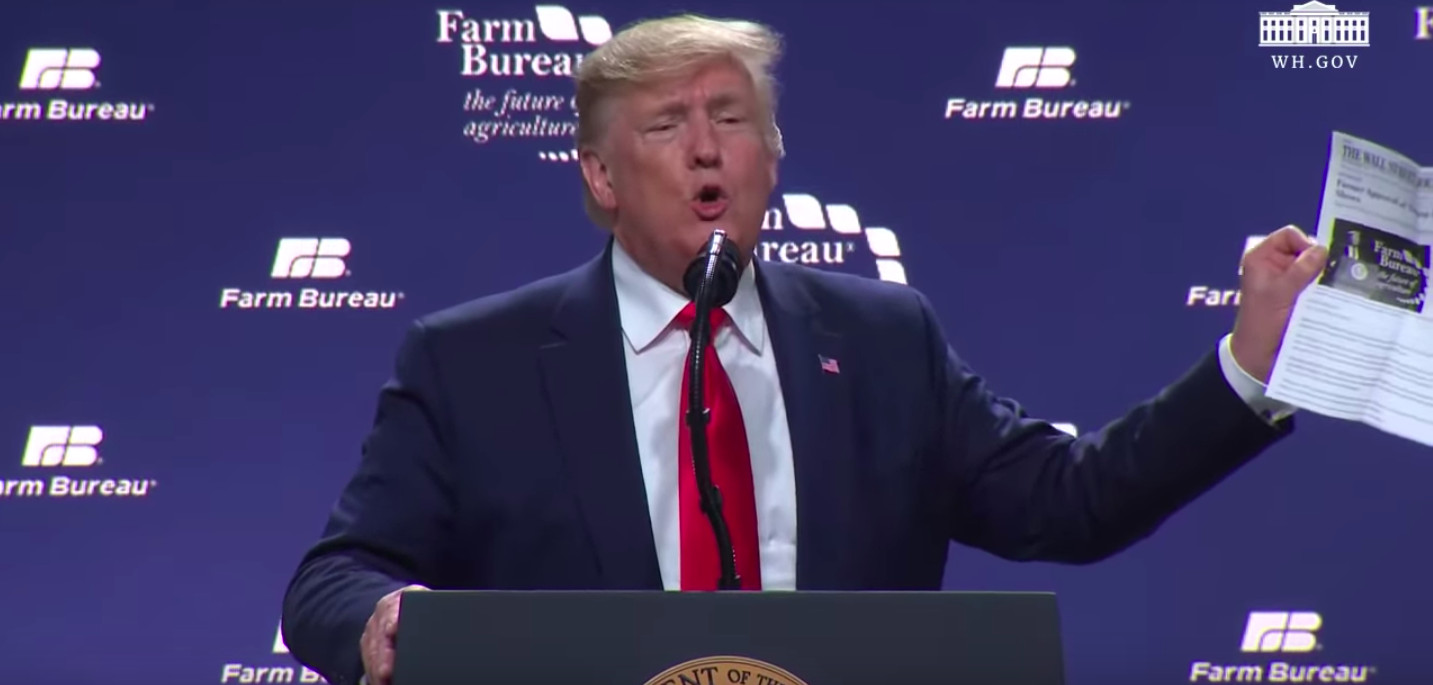On the off chance that you weren’t watching President Trump address the American Farm Bureau Federation’s convention in January, here’s what he told the appreciative crowd:
“A poll just came out — Wall Street Journal. It just came out. Look at this: ‘Farmer Approval of Trump Hits Record, Poll Shows… 83 percent of the farmers and ranchers approve of the President’s job performance.’ 83 percent!”
Such a lofty approval rating might seem suspicious, given the havoc that Trump’s tariffs—and retaliatory actions by China and other countries—have brought to the agriculture business. Farm bankruptcies rose 20 percent last year, while Trump keeps promising farmers even greater payouts to stem their losses.
These suspicions are well-founded. Trump misled his audience on several counts: The “poll” wasn’t a poll at all—certainly not one that would be recognized by experts who do this for a living. Nor was it conducted by the Wall Street Journal.
THE MEDIA TODAY: The Sunday shows fail to link the coronavirus and the campaign
That 83 percent figure got its start at Farm Journal, a trade publication that covers the agriculture industry. Farm Journal invites its audience to participate in occasional surveys—something that anyone can see by texting “PULSE” to a widely available number. About 5,000 people—“recruited from our ag-related universe of digital offerings,”says John Herath, news director for Farm Journal Media—have signed up.
Once a month, Herath says, Farm Journal asks the group how they feel about Trump. In the January survey, nearly 1,300 people voted; of those, 64 percent responded “strongly approve,” and 19 percent responded “somewhat approve.” Adding those together gives us the 83 percent figure that Trump touted right after that survey was reported.
But this survey isn’t remotely like a poll, which would use random sampling to ensure a wide field of respondents, and would provide a margin of error, along with crosstabs to show how different groups respond.
Such a survey “is highly suspect,” says Robert Shapiro, a Columbia University professor, former chair of the Political Science department, and an expert on political polling. “It’s not transparent with how they came up with the people” who responded, Shapiro notes. “There could be enormous biases.”
Those flaws didn’t stop the survey from being picked up by conservative sites, including Breitbart and the National Review, with the credulousness that typifies many partisan outlets.
Coverage wasn’t limited to right-wing news organizations. The Wall Street Journal also published a story, reporting the “poll” showed that “83% of farmers and ranchers approve of the president’s job performance. … the highest level of support for Mr. Trump among farmers since he took office.” While the Journal story noted the methodology, it didn’t scrutinize Farm Journal’s techniques.
The imprimatur of such a credible news outlet might not have been lost on Trump, or his speechwriter, since they cited the Journal as the survey’s source.
The Journal doesn’t have much to say about the story now. Asked to explain why they published it, spokesman Steve Severinghaus sent this one-sentence reply: “The Wall Street Journal has no affiliation with Farm Journal or this survey, which we do not typically cover.”
There are reasons to think the survey’s results are flawed. A December 2019 poll by Reuters/Ipsos showed that, among those involved in agriculture, “49% approved of the way Trump is handling American farming and 40% disapproved.” That’s a much lower rating, though it’s also a slightly different question than the Farm Journal’s, which focused on overall presidential approval. Herath sticks with his outlet’s findings: “Anecdotally, I must say the numbers from our poll are much closer to what I hear from farmers and ranchers than what is reflected in the Reuters/Ipsos poll.”
No matter. Between conservative media, the Wall Street Journal, and President Trump, this 83-percent rating has taken hold. Even liberal talk-show host Bill Maher cited it a few weeks ago when interviewing Amy Klobuchar, the US senator from Minnesota who’s running for president. “Why do 83 percent of farmers say they’re for Trump?” Maher asked. A perplexed Klobuchar replied, “Um, well, that’s where they may be in the past… I don’t think it’s going to be where they are in 2020.”
Perverse motives can come into play when journalists report on polls. A big number will drive a big headline. And even if one survey’s methods are suspect, there’s always another one a few days later to take its place. “The biases of journalism are related to conflict or news or surprise,” says Shapiro, the Columbia professor. “There are always incentives to publish, just to get attention.”
Bill Grueskin is on the faculty at Columbia Journalism School. He has previously worked as founding editor of a newspaper on the Standing Rock Sioux Indian Reservation, city editor of the Miami Herald, deputy managing editor of the Wall Street Journal, and an executive editor at Bloomberg News. He is a graduate of Stanford University (Classics) and Johns Hopkins’s School of Advanced International Studies (US Foreign Policy and International Economics).

